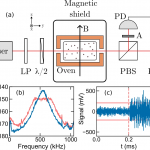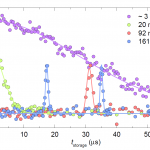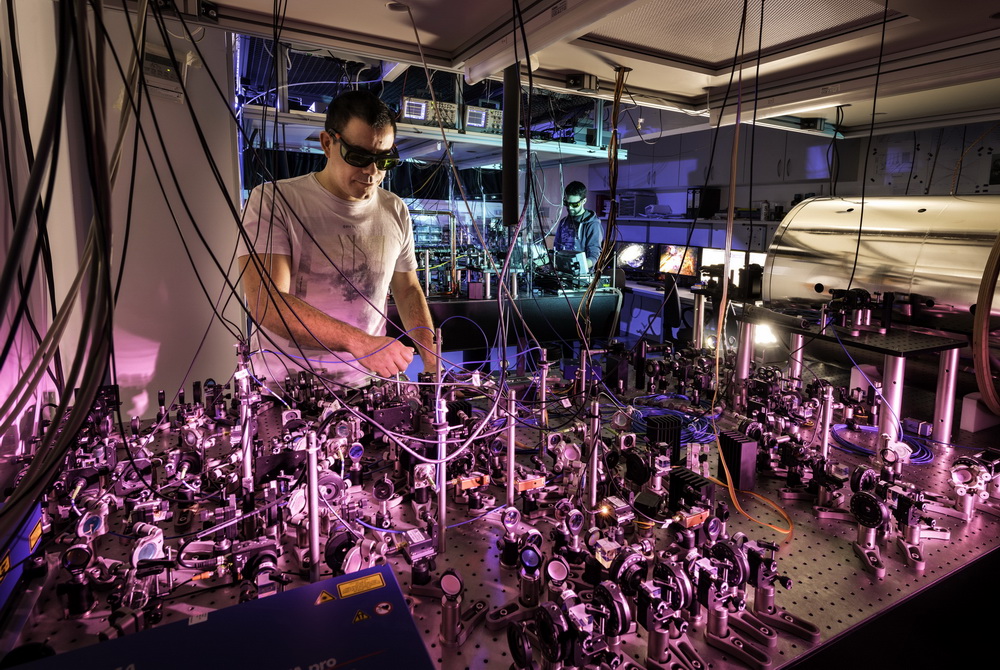Welcome to the website of the Slovenian cold atom lab. We use an ultracold quantum gas of cesium to explore matter waves and to develop quantum devices.
BEC is a state of coupled bosonic atoms at a temperature near absolute zero. Under these conditions, a large fraction of the atoms occupy the lowest quantum state, while the quantum nature of atoms is manifested in the form of superfluidity. The superfluidity is a macroscopic phenomenon where the material behaves as a quantum fluid that flows without viscosity and is analogous to the phenomenon of superconductivity in solids. Because of this analogy the BEC can be used as a quantum simulator of solid state physics, e.g., to study superconductivity and, in more general, to explore the physics of strongly correlated electrons.
Recent highlights
- Mbit/s-range alkali vapour spin noise quantum random number generators
 Our paper on quantum random number generators was published in NPJ Quantum Technology! In the paper, we explore spin noise based quantum random number generators. This type of quantum random number generators first appeared in 2008 and have since then garnered little further interest, in part because their bit rate is limited by the transverse…
Our paper on quantum random number generators was published in NPJ Quantum Technology! In the paper, we explore spin noise based quantum random number generators. This type of quantum random number generators first appeared in 2008 and have since then garnered little further interest, in part because their bit rate is limited by the transverse… - Suppression of dark-state polariton collapses in a cold-atom quantum memory
 Our paper on quantum memory collapses and revivals was published in Physical Review A! In the paper, we show our experimental observation of dark-state polariton collapses and revivals in a quantum memory based on electromagnetically induced transparency on a cloud of cold cesium atoms in a magnetic field. We suppress the dark-state polariton collapses by…
Our paper on quantum memory collapses and revivals was published in Physical Review A! In the paper, we show our experimental observation of dark-state polariton collapses and revivals in a quantum memory based on electromagnetically induced transparency on a cloud of cold cesium atoms in a magnetic field. We suppress the dark-state polariton collapses by…
Using lasers and magnetooptical trap the cesium atoms in the ultrahigh vacuum are first slowed down and caught, and thus cooled to the temperature range of several hundred μK. In the next step, by means of Raman transitions, the cesium atoms end up in one of the well-defined low-lying energy states and the temperature falls below 1 μK. At the same time the atoms are caught in the so-called optical trap by a set of extremely powerful laser beams. The atoms are further cooled by evaporation, which lowers the temperature to the range of nK, which is low enough for the atoms to condense.

Selected Publications
| Preparation of ultra-cold atomic-ensemble arrays using time-multiplexed optical tweezers Katja Gosar, Vesna Pirc Jevšenak, Tadej Mežnaršič, Dušan Babič, Igor Poberaj, Erik Zupanič, and Peter Jeglič Phys. Rev. A 106, 022604 (2022), arXiv:2203.11617 |
| Single-shot Stern-Gerlach magnetic gradiometer with an expanding cloud of cold cesium atoms Katja Gosar, Tina Arh, Tadej Mežnaršič, Ivan Kvasič, Dušan Ponikvar, Tomaž Apih, Rainer Kaltenbaek, Rok Žitko, Erik Zupanič, Samo Beguš, and Peter Jeglič Phys. Rev. A 103, 022611 (2021), arXiv:2011.09779 |
| Emission of correlated jets from a driven matter-wave soliton in a quasi-one-dimensional geometry Tadej Mežnaršič, Rok Žitko, Tina Arh, Katja Gosar, Erik Zupanič, and Peter Jeglič Phys. Rev. A 101, 031601(R) (2020), arXiv:1905.10286 |
| Cesium bright matter-wave solitons and soliton trains Tadej Mežnaršič, Tina Arh, Jure Brence, Jaka Pišljar, Katja Gosar, Žiga Gosar, Rok Žitko, Erik Zupanič, and Peter Jeglič Phys. Rev. A 99, 033625 (2019), arXiv:1902.03144 |
Ongoing Projects
Physics of quantum and functional materials
Physics of quantum technologies
Development of building blocks for new European quantum communication network
Latest news
- Mbit/s-range alkali vapour spin noise quantum random number generators
 Our paper on quantum random number generators was published in NPJ Quantum Technology! In the paper, we explore spin noise based quantum random number generators. This type of quantum random number generators first appeared in 2008 and have since then garnered little further interest, in part because their bit rate is limited by the transverse…
Our paper on quantum random number generators was published in NPJ Quantum Technology! In the paper, we explore spin noise based quantum random number generators. This type of quantum random number generators first appeared in 2008 and have since then garnered little further interest, in part because their bit rate is limited by the transverse… - Suppression of dark-state polariton collapses in a cold-atom quantum memory
 Our paper on quantum memory collapses and revivals was published in Physical Review A! In the paper, we show our experimental observation of dark-state polariton collapses and revivals in a quantum memory based on electromagnetically induced transparency on a cloud of cold cesium atoms in a magnetic field. We suppress the dark-state polariton collapses by…
Our paper on quantum memory collapses and revivals was published in Physical Review A! In the paper, we show our experimental observation of dark-state polariton collapses and revivals in a quantum memory based on electromagnetically induced transparency on a cloud of cold cesium atoms in a magnetic field. We suppress the dark-state polariton collapses by…